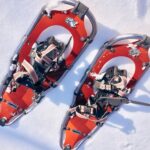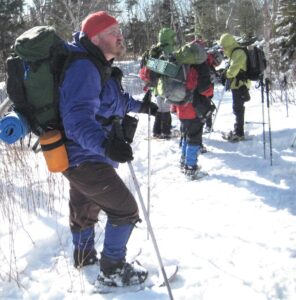Doctor Trail-love Or: How I Learned to Stop Postholing and Love My Snowshoes
By Wes Tucker
I'll grant you, the snow amounts so far this winter have been underwhelming. But it's winter in New Hampshire, and that usually means snow… lots of snow. So when the snow does fall, and you plan to hike the trails, you’re going to need a pair of snowshoes. Many new winter hikers may think that they're saving themselves a little effort by foregoing snowshoes and “bare-booting it” on the snow covered trails. Of course there is nothing wrong with this per se, as long as the snow conditions warrant it. The question is when should we give up hoofing it with just boots, and maybe some traction aides, and put on the snowshoes?
A good rule of thumb to use is “the 3 inch rule”. When your boots sink into the snow more then 3 inches, stop and put on your snowshoes. Why do we need to do this? So we don’t wreck the trail for all those coming after us. Even if you are staying afloat most of the time without snowshoes, you will occasionally sink down to mid-shin or deeper. You pull your leg out and continue on, leaving behind a large hole commonly known as a "posthole". Maybe it only happens a few times to you. Then it only happens a few times to the others in your group. Then it happens only a few times to everyone in the next group on the trail. You can see that it doesn’t take long until the trail becomes a minefield of postholes. It can get to the point where a trail is so badly torn up with postholes, it became impossible use snowshoes. Now when the weather gets like it often does this time of year; where it warms up, rains, then gets wicked cold, all the trail damage sets up like cement. Then we are stuck with it at least until Mother Nature decides to bless us with another big dump (of snow) or a big thaw.
Some people think that it’s just not worth the extra effort to hike with snowshoes on. The truth is, unless the trail has turned as solid as a sidewalk, they're probably wasting a lot of energy by not using snowshoes. You get better traction and take a more natural stride then if you were hiking through deep snow with boots alone. Once you get the hang of it, using snowshoes is a lot more efficient than going without. Besides, it’s just a lot more fun!
Another common mistake is to assume the snow conditions at the trailhead will be the same for the rest of the trail. When you leave your car and start bare booting up that firmly packed trail, don’t snicker at the poor saps who are lugging snowshoes up the mountain strapped to their packs. You may think that you're the only one smart enough to leave you snowshoes behind, but it’s more likely that they know something you don’t. They know that the snow conditions over the course of any hike can change radically. This is especially true when large elevation changes are involved.
I’m not saying that any of you are doing this. I know in my deep in my soul that you, dear reader, would never be caught doing such a careless and heinous act (wink, wink). But there seems to be a lot of people out on the trails that don’t have your knowledge, experience, and respect for our fellow hikers. There are theories for this phenomenon; several winters with low snowfall, or advances in gear and technology drawing 3-season hikers into the 4-season range without changing their habits. We’ll probably never know for sure, but the question is what can we do about it?
Education is the answer. When you’re on the trails this winter, explain to your hiking partners why you are wearing snowshoes. Try to make them understand the reasoning behind it so they will be armed with that knowledge on future winter treks. Hopefully they’ll pass on the knowledge to others. When you meet hikers on the trail who are punching holes in it, try to explain to them why it is so important that they stop and put on the snowshoes (assuming they will at least be carrying them). When all else fails, try the guilt route. Tell them how selfish it is not to think of those that come after them.
Well, I’m getting kind of dizzy up here in my pulpit, so I think I'll shut up now. I hope to see you, and your snowshoes, out on the trails.


